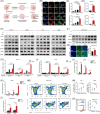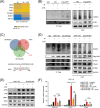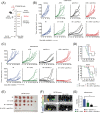Combining radiation and the ATR inhibitor berzosertib activates STING signaling and enhances immunotherapy via inhibiting SHP1 function in colorectal cancer
- PMID: 36855844
- PMCID: PMC10091106
- DOI: 10.1002/cac2.12412
Combining radiation and the ATR inhibitor berzosertib activates STING signaling and enhances immunotherapy via inhibiting SHP1 function in colorectal cancer
Abstract
Background: Immune checkpoint inhibitors (ICIs) targeting programmed cell death protein 1 (PD-1) and programmed death-ligand 1 (PD-L1) have shown a moderate response in colorectal cancer (CRC) with deficient mismatch repair (dMMR) functions and poor response in patients with proficient MMR (pMMR). pMMR tumors are generally immunogenically "cold", emphasizing combination strategies to turn the "cold" tumor "hot" to enhance the efficacy of ICIs. ATR inhibitors (ATRi) have been proven to cooperate with radiation to promote antitumor immunity, but it is unclear whether ATRi could facilitate the efficacy of IR and ICI combinations in CRCs. This study aimed to investigate the efficacy of combining ATRi, irradiation (IR), and anti-PD-L1 antibodies in CRC mouse models with different microsatellite statuses.
Methods: The efficacy of combining ATRi, IR, and anti-PD-L1 antibodies was evaluated in CRC tumors. The tumor microenvironment and transcriptome signatures were investigated under different treatment regimens. The mechanisms were explored via cell viability assay, flow cytometry, immunofluorescence, immunoblotting, co-immunoprecipitation, and real-time quantitative PCR in multiple murine and human CRC cell lines.
Results: Combining ATRi berzosertib and IR enhanced CD8+ T cell infiltration and enhanced the efficacy of anti-PD-L1 therapy in mouse CRC models with different microsatellite statuses. The mechanistic study demonstrated that IR + ATRi could activate both the canonical cGAS-STING-pTBK1/pIRF3 axis by increasing cytosolic double-stranded DNA levels and the non-canonical STING signaling by attenuating SHP1-mediated inhibition of the TRAF6-STING-p65 axis, via promoting SUMOylation of SHP1 at lysine 127. By boosting the STING signaling, IR + ATRi induced type I interferon-related gene expression and strong innate immune activation and reinvigorated the cold tumor microenvironment, thus facilitating immunotherapy.
Conclusions: The combination of ATRi and IR could facilitate anti-PD-L1 therapy by promoting STING signaling in CRC models with different microsatellite statuses. The new combination strategy raised by our study is worth investigating in the management of CRC.
Keywords: ATR inhibitor; DNA damage; PD-L1; SHP1; SUMOylation; cGAS-STING; colorectal cancer; immune checkpoint inhibitor; innate immunity; radiotherapy.
© 2023 The Authors. Cancer Communications published by John Wiley & Sons Australia, Ltd. on behalf of Sun Yat-sen University Cancer Center.
Conflict of interest statement
All authors have no conflicts of interests to declare.
Figures







Similar articles
-
WEE1 inhibitor and ataxia telangiectasia and RAD3-related inhibitor trigger stimulator of interferon gene-dependent immune response and enhance tumor treatment efficacy through programmed death-ligand 1 blockade.Cancer Sci. 2021 Nov;112(11):4444-4456. doi: 10.1111/cas.15108. Epub 2021 Aug 31. Cancer Sci. 2021. PMID: 34382294 Free PMC article.
-
Blocking IL-17A enhances tumor response to anti-PD-1 immunotherapy in microsatellite stable colorectal cancer.J Immunother Cancer. 2021 Jan;9(1):e001895. doi: 10.1136/jitc-2020-001895. J Immunother Cancer. 2021. PMID: 33462141 Free PMC article.
-
ATR inhibitor AZD6738 enhances the antitumor activity of radiotherapy and immune checkpoint inhibitors by potentiating the tumor immune microenvironment in hepatocellular carcinoma.J Immunother Cancer. 2020 May;8(1):e000340. doi: 10.1136/jitc-2019-000340. J Immunother Cancer. 2020. PMID: 32461345 Free PMC article.
-
Immunotherapy efficacy on mismatch repair-deficient colorectal cancer: From bench to bedside.Biochim Biophys Acta Rev Cancer. 2020 Dec;1874(2):188447. doi: 10.1016/j.bbcan.2020.188447. Epub 2020 Oct 6. Biochim Biophys Acta Rev Cancer. 2020. PMID: 33035640 Free PMC article. Review.
-
PD-1 and PD-L1 inhibitors in cold colorectal cancer: challenges and strategies.Cancer Immunol Immunother. 2023 Dec;72(12):3875-3893. doi: 10.1007/s00262-023-03520-5. Epub 2023 Oct 13. Cancer Immunol Immunother. 2023. PMID: 37831146 Free PMC article. Review.
Cited by
-
Redox Signaling Modulates Activity of Immune Checkpoint Inhibitors in Cancer Patients.Biomedicines. 2023 Apr 29;11(5):1325. doi: 10.3390/biomedicines11051325. Biomedicines. 2023. PMID: 37238995 Free PMC article. Review.
-
The cGAS-STING pathway: a dual regulator of immune response in cancer and therapeutic implications.J Transl Med. 2025 Jul 10;23(1):766. doi: 10.1186/s12967-025-06843-2. J Transl Med. 2025. PMID: 40640925 Free PMC article. Review.
-
Targeting ATR Pathway in Solid Tumors: Evidence of Improving Therapeutic Outcomes.Int J Mol Sci. 2024 Feb 27;25(5):2767. doi: 10.3390/ijms25052767. Int J Mol Sci. 2024. PMID: 38474014 Free PMC article. Review.
-
A Bifunctional Antibody Targeting PD-1 and TGF-β Signaling Has Antitumor Activity in Combination with Radiotherapy and Attenuates Radiation-Induced Lung Injury.Cancer Immunol Res. 2025 May 2;13(5):767-784. doi: 10.1158/2326-6066.CIR-23-0903. Cancer Immunol Res. 2025. PMID: 39878763 Free PMC article.
-
A protease-cleavable liposome for co-delivery of anti-PD-L1 and doxorubicin for colon cancer therapy in mice.Nat Commun. 2025 Mar 24;16(1):2854. doi: 10.1038/s41467-025-57965-6. Nat Commun. 2025. PMID: 40128211 Free PMC article.
References
-
- Siegel RL, Miller KD, Jemal A. Cancer statistics, 2020. CA: A Cancer Journal for Clinicians. 2020;70(1):7‐30. - PubMed
-
- van der Geest LGM, Jt Lam‐Boer, Koopman M, Verhoef C, Elferink MAG, de Wilt JHW. Nationwide trends in incidence, treatment and survival of colorectal cancer patients with synchronous metastases. Clinical & experimental metastasis. 2015;32(5):457‐65. - PubMed
-
- Killock D. Immunotherapy: PD‐1 blockade exploiting MMR deficiency. Nature Reviews Clinical Oncology. 2017;14(8):459. - PubMed
Publication types
MeSH terms
Substances
LinkOut - more resources
Full Text Sources
Other Literature Sources
Medical
Research Materials
Miscellaneous

